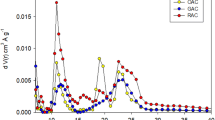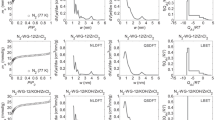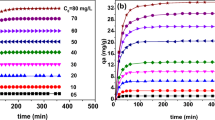Abstract
We proposed to evaluate the performance of new adsorption materials in relation to existing commercial products by comparing the values of the standard molar adsorption energy of \(\Delta G_{{\text{a}}}^{^\circ }\) of adsorbates. A typical error in the determination of \(\Delta G_{{\text{a}}}^{^\circ }\) is due to the incorrect calculation of the adsorption equilibrium constant Ke. It is often calculated in isothermal regions that do not correspond to standard adsorption conditions, or the dimensional constant of the Langmuir model equation KL is falsely used as a thermodynamic constant. The direct use of the Langmuir constant KL as an equilibrium constant is a thermodynamically invalid approach; however, due to the simplicity of determining KL, an estimate of the adsorption energy based on it can become an accessible and useful tool for adsorption studies. In this work, we examined two methods to transform the Langmuir constant into surrogate constants, which, according to formal features, are dimensionless quantities and reflect the conditional energy of adsorption. We selected 16 adsorption systems of activated carbon (F300, KAU, KAU/Fe, Akant) with aqueous solutions of sparingly soluble aromatic compounds of the phenol and aniline series. We compared the adsorption energy values obtained from the Langmuir constant and the thermodynamically verified constant of the partial adsorption isotherm, calculated by the procedure developed by A.M. Koganovskii (the Koganovskii method, KM). The deviations of the adsorption energy values calculated from the Langmuir constant are on average 10–15% compared to the results obtained by the Koganovskii method. To plot the adsorption isotherms of aromatic compounds, a simplified algorithm for calculating Ke according to the KM was proposed and tested (without considering the volume of the adsorption phase and the molar volume of adsorbents). Deviations in energy values were within 5% of the KM results. Thus, the considered simplified methods are easy to implement and accurate enough to estimate the standard adsorption energy; therefore, they can be recommended for the initial assessment of the effectiveness of new adsorption materials.
Similar content being viewed by others
REFERENCES
Sun, S., Yu, Q., Li, M., Zhao, H., Wang, Y., and Ji, X., Effect of carbonization temperature on characterization and water vapor adsorption of coffee-shell activated carbon, Adsorpt. Sci. Technol., 2020, vol. 38, nos. 9–10, pp. 377–392. https://doi.org/10.1177/0263617420950994
Zhao, H., Yu, Q., Li, M., and Sun, S., Preparation and water vapor adsorption of “green” walnut-shell activated carbon by CO2 physical activation, Adsorpt. Sci. Technol., 2020, vol. 38, nos. 1–2, pp. 60–76. https://doi.org/10.1177/0263617419900849
Ai, T., Jiang, X., Zhong, Z., Li, D., and Dai, S., Methanol modified ultra-fine magnetic orange peel powder biochar as an effective adsorbent for removal of ibuprofen and sulfamethoxazole from water, Adsorpt. Sci. Technol., 2020, vol. 38, nos. 7–8, pp. 304–321. https://doi.org/10.1177/0263617420944659
Dizbay-Onat, M., Vaidya, U.K., Jo Balanay, A.G., and Lungu, C.T., Preparation and characterization of flax, hemp and sisal fiber-derived mesoporous activated carbon adsorbents, Adsorpt. Sci. Technol., 2018, vol. 36, nos. 1–2, pp. 441–457. https://doi.org/10.1177/0263617417700635
Guo, X., Tan, S., Song, Ya., and Nan, J., Adsorptive removal of Ni2+ and Cd2+ from wastewater using a green longan hull adsorbent, Adsorpt. Sci. Technol., 2018, vol. 36, nos. 1–2, pp. 762–773. https://doi.org/10.1177/0263617417722254
Tran, H.N., Chao, H.-P., and You, S.-J., Activated carbon from golden shower upon different chemical activation methods: Synthesis and characterizations, Adsorpt. Sci. Technol., 2018, vol. 36, nos. 1–2, pp. 95–113. https://doi.org/10.1177/0263617416684837
Idal, I.J., Abdullah, L.C., Choong, T.Sy, and Jamil, S.N., Equilibrium kinetics and thermodynamic adsorption studies of acid dyes on adsorbent developed from kenaf core fiber, Adsorpt. Sci. Technol., 2018, vol. 36, nos. 1–2, pp. 694–712. https://doi.org/10.1177/0263617417715532
Rodrigues, L.A., Pinto da Silva, M.L.C., Alvarez-Mendesc, M.O., Coutinho, A.R., and Thima G.P., Phenol removal from aqueous solution by activated carbon produced from avocado kernel seeds, Chem. Eng. J., 2011, vol. 174, pp. 49–57.
Lin, S-H. and Juang, R-S., Adsorption of phenol and its derivatives from water using synthetic resins and low-cost natural adsorbents: A review, Chem. Eng. J., 2009, vol. 90, pp. 1336–1349.
Tan, I.A.W., Ahmad, A.L., and Hameed, B.H., Adsorption isotherms, kinetics, thermodynamics and desorption studies of 2,4,6-trichlorophenol on oil palm empty fruit bunch-based activated carbon, J. Hazard. Mater., 2009, vol. 164, pp. 473–482. https://doi.org/10.1016/j.jhazmat.2008.08.025
Ioannidou, O. and Zabaniotou, A., Agricultural residues as precursors for activated carbon production—A review, Renewable Sustainable Energy Rev., 2007, vol. 11, pp. 1966–2005.
Koganovskii, A.M., Klimenko, N.A., Levchenko, T.M., and Roda, I.G., Adsorbtsiya organicheskikh veshchestv iz void (Adsorption of Organic Substances from Water), Kyiv, 1990.
Daniels, F. and Alberty, L.A., Physical Chemistry, New York: Wiley, 1975.
Gupta, V.K., Gupta, B., Rastogi, A., Agarwal, S., and Nayak, A., A comparative investigation on adsorption performances of mesoporous activated carbon prepared from waste rubber tire and activated carbon for a hazardous azo dye—Acid Blue, J. Hazard. Mater., 2011, vol. 186, pp. 891–901. https://doi.org/10.1016/j.jhazmat.2010.11.091
El-Naas, M.H., Al-Zuhair, S., and Alhaija, M.A., Removal of phenol from petroleum refinery wastewater through adsorption on date-pit activated carbon, Chem. Eng. J., 2010, vol. 162, pp. 997–1005.
Senturk, H.B., Ozdes, D., Gundogdu, A., Duran, C., and Soylak, M., Removal of phenol from aqueous solutions by adsorption onto organomodified Tirebolu bentonite: Equilibrium, kinetic and thermodynamic study, J. Hazard. Mater., 2009, vol. 172, pp. 353–362. https://doi.org/10.1016/j.jhazmat.2009.07.019
Sheng, G.D., Shao, D.D., Ren, X.M., Wang, X.Q., Li, J.X., Chen, Y.X., and Wang, X.K., Kinetics and thermodynamics of adsorption of ionizable aromatic compounds from aqueous solutions by as-prepared and oxidized multiwalled carbon nanotubes, J. Hazard. Mater., 2010, vol. 178, pp. 505–516. https://doi.org/10.1016/j.jhazmat.2010.01.110
Sathishkumar, M., Binupriya, A.R., Kavitha, D., Selvakumar, R., Jayabalan, R., Choi, J.G., and Yun, S.E., Adsorption potential of maize cob carbon for 2,4-dichlorophenol removal from aqueous solutions: Equilibrium, kinetics and thermodynamics modeling, Chem. Eng. J., 2009, vol. 147, pp. 265–271. https://doi.org/10.1016/j.cej.2008.07.020
Rodrigues, L.A., de Sousa Ribeiro, L., Thim, G.P., Ferreira, R.R., Alvarez-Mendez, M.O., and dos Reis Coutinho, A., Activated carbon derived from macadamia nut shells: An effective adsorbent for phenol removal, J. Porous Mater., 2013, vol. 20, pp. 619–627. https://doi.org/10.1007/s10934-012-9635-5
Cui, L., Yan, J., Quan, G., Ding, C., Chen, T., and Hussain, Q., Adsorption behaviour of pymetrozine by four kinds of biochar from aqueous solution, Adsorpt. Sci. Technol., 2013, vol. 31, no. 6, pp. 477–487.
Baskaran, P.K., Venkatraman, B.R., Hema, M., and Arivoli, S., Adsorption studies of copper ion by low cost activated carbon, J. Chem. Pharm. Res., 2010, vol. 2, no. 5, pp. 642–655.
Purkait, M.K., Maiti, A., Das Gupta, S., and De, S., Removal of Congo Red using activated carbon and its regeneration, J. Hazard. Mater., 2007, vol. 145, pp. 287–295.
Aksu, Z. and Isoglu, I.A., Removal of copper(II) ions from aqueous solution by biosorption onto agricultural waste sugar beet pulp, Process Biochem., 2005, vol. 40, pp. 3031–3044.
Adamson, A., The Physical Chemistry of Surfaces, New York: Wiley, 1976.
Zabneva, O.V., Smolin, S.K., Shvidenko, O.G., and Klymenko, N.A., Biosorption removal of nitrophenols by activated carbon, J. Water Chem. Technol., 2014, vol. 36, pp. 97–101. https://doi.org/10.3103/S1063455X14020088
Smolin, S.K., Zabneva, O.V., Nevynna L.V., and Synelnikova A.V., Equilibrium adsorption of phenol from water by activated carbon of different brands, J. Water Chem. Technol., 2023, vol. 45, no. 1, pp. 30–36. https://doi.org/10.3103/S1063455X23010095
Smolin, S.K., Zabneva, O.V., Synelnikova, A.V., and Shvydenko, O.G., Effect of a substituent in the benzene ring on the adsorption properties of the activated carbon–aromatic substance system, J. Water Chem. Technol., 2023, vol. 45, no. 3, pp. 270–278. https://doi.org/10.3103/S1063455X23030104
Author information
Authors and Affiliations
Corresponding author
Ethics declarations
The authors declare that they have no conflicts of interest.
Additional information
Translated by O. Zhukova
About this article
Cite this article
Smolin, S.K., Zabneva, O.V. Using Surrogate Equilibrium Constants for Assessing the Energy of Adsorption of Synthetic Organic Substances from Aqueous Phase onto Carbonized Adsorbents. J. Water Chem. Technol. 45, 467–474 (2023). https://doi.org/10.3103/S1063455X23050107
Received:
Revised:
Accepted:
Published:
Issue Date:
DOI: https://doi.org/10.3103/S1063455X23050107




